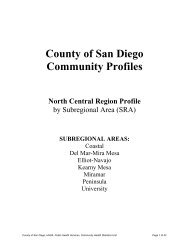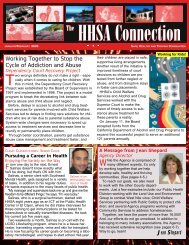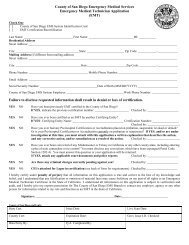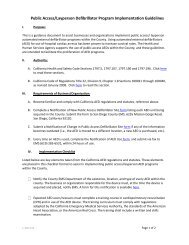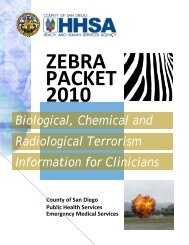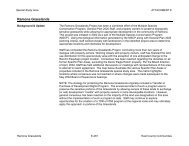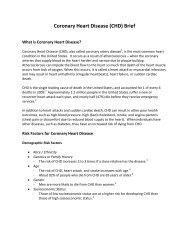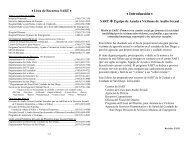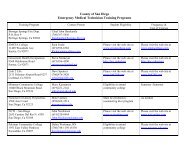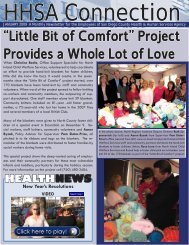CALIFORNIA CODE OF REGULATIONS - State of California
CALIFORNIA CODE OF REGULATIONS - State of California
CALIFORNIA CODE OF REGULATIONS - State of California
Create successful ePaper yourself
Turn your PDF publications into a flip-book with our unique Google optimized e-Paper software.
Page 495<br />
TITLE 9. DIVISION 1 — DEPARTMENT <strong>OF</strong> MENTAL HEALTH § 1115<br />
Acute Mental Health Care Census:<br />
1–5 6–10 11–20 21–30 31–40 41–50 51–60 61–70 71–80 81–90 91–100<br />
Staff:<br />
Psychiatrist or Clinical<br />
Psychologist or Licensed<br />
Clinical Social Worker or<br />
Licensed Marriage,<br />
Family and Child<br />
Counselor, or Psychiatric<br />
Mental Health Nurse<br />
.5 1 2 3 4 5 6 7 8 9 10<br />
Registered Nurse or<br />
Licensed Vocational<br />
Nurse or Psychiatric<br />
Technician 3 4 5 6 8 10 12 14 16 18 20<br />
Mental Health<br />
Worker 1.5 3 5 8 10 13 15 18 20 23 25<br />
TOTALS 5 8 12 17 22 28 33 39 44 50 55<br />
NOTE: Authority cited: Sections 1250.1(a)(12) and 1267.10(a),<br />
Health and Safety Code. Reference: Sections 1250(j) and 1254,<br />
Health and Safety Code.<br />
§ 1113. Mental Health Treatment Program<br />
Staffing—Nonacute Care Requirements.<br />
Nonacute 24–hour mental health care may be provided by any<br />
correctional treatment center meeting the basic staffing requirements<br />
specified in 22 CCR Section 79631, Nursing Service– Staff Required<br />
Services, including the requirements for 2.5 nursing hours per patient<br />
day, and by the Mental Health Treatment Program Staffing—Basic<br />
Requirements, set forth in Section 791.<br />
NOTE: Authority cited: Sections 1250.1(a)(12) and 1267.10(a),<br />
Health and Safety Code. Reference: Sections 1250(j) and 1254,<br />
Health and Safety Code.<br />
§ 1114. Mental Health Treatment Program—Space.<br />
Space shall be provided for the conduct <strong>of</strong> the mental health<br />
treatment program and shall include:<br />
(1) A consultation room for interviewing.<br />
(2) An observation room for acutely disturbed inmate–patients.<br />
(3) Indoor or outdoor facilities for therapeutic activities.<br />
NOTE: Authority cited: Sections 1250.1(a)(12) and 1267.10(a),<br />
Health and Safety Code. Reference: Sections 1250(j) and 1254,<br />
Health and Safety Code.<br />
§ 1115. Clinical Restraint, Treatment Restraint, and Clinical<br />
Seclusion.<br />
(a) Written policies and procedures concerning the use <strong>of</strong> clinical<br />
restraint, treatment restraint, and clinical seclusion shall be developed<br />
and approved by the correctional treatment center administration.<br />
(b) Clinical restraint and clinical seclusion shall be based on a<br />
written or verbal order <strong>of</strong> a psychiatrist or clinical psychologist.<br />
Clinical restraint shall additionally require a physician’s or<br />
physician’s assistant’s, or nurse practitioner’s written or verbal<br />
approval operating under the supervision <strong>of</strong> a physician. The order<br />
shall include the reason for restraint or seclusion and the types <strong>of</strong><br />
restraints. Under emergency circumstances, clinical restraint or<br />
clinical seclusion may be applied and then an approval and/or an order<br />
shall be obtained as soon as possible, but at least within one hour <strong>of</strong><br />
application. Emergency circumstances exist when there is a sudden<br />
marked change in the inmate–patient’s condition so that action is<br />
immediately necessary for the preservation <strong>of</strong> life or the prevention<br />
<strong>of</strong> serious bodily harm to the inmate–patient or others, and it is<br />
impractical to first obtain an order and approval. Telephone orders<br />
and approvals for clinical restraint and clinical seclusion shall be<br />
received only by licensed medical and mental health care staff, shall<br />
be recorded immediately in the inmate–patient’s health record, and<br />
shall be signed within twenty–four (24) hours.<br />
(c) A physician shall complete a medical assessment <strong>of</strong> an<br />
inmate–patient at the earliest opportunity but not later than twenty<br />
four (24) hours after the inmate–patient has been placed in a clinical<br />
restraint or clinical seclusion.<br />
(d) Clinical restraint, treatment restraint and clinical seclusion shall<br />
only be used as a measure to prevent injury to self or others. Clinical<br />
restraint, treatment restraint and clinical seclusion shall only be used<br />
when less restrictive alternative methods are not sufficient to protect<br />
the inmate–patient or others from injury, and shall not be used as<br />
punishment or as a substitute for more effective programming or for<br />
the convenience <strong>of</strong> the staff. Removing an inmate–patient from an<br />
activity or area to another unlocked area for a period <strong>of</strong> time as a way<br />
to use separation as a behavioral modification technique shall not be<br />
considered clinical seclusion.<br />
(e) Each order for clinical restraint and clinical seclusion shall be<br />
in force no longer than twenty–four (24) hours.<br />
(f) There shall be no PRN orders (as needed orders) for clinical<br />
restraint and clinical seclusion.<br />
(g) An inmate–patient placed in a clinical restraint shall be<br />
physically checked at least every fifteen (15) minutes by nursing staff<br />
to assure that the restraints remain properly applied, that circulation<br />
is not impaired, that the inmate–patient is not in danger <strong>of</strong> harming<br />
himself or herself, and that other medical problems are not present.<br />
Fluids and nourishment shall be provided every two (2) hours, except<br />
during sleep. An opportunity to use a toilet or, when necessary, an<br />
alternative shall be provided every two hours, except during sleep. An<br />
inmate–patient placed in clinical seclusion shall be checked by<br />
nursing staff at least every fifteen (15) minutes. Routine range <strong>of</strong><br />
motion exercises shall be done with clinically restrained<br />
inmate–patients for at least ten (10) minutes every two hours. A<br />
written record shall be kept <strong>of</strong> these checks and exercises, and<br />
maintained in the individual inmate–patient health record.<br />
(h) The inmate–patient’s health record shall include written<br />
justification for the application <strong>of</strong> clinical restraints, note the times <strong>of</strong><br />
application and removal <strong>of</strong> clinical restraints and document the<br />
inmate–patient’s status, the judgment <strong>of</strong> a physician or clinical<br />
psychologist on the necessity <strong>of</strong> continuing the order, and the<br />
approval <strong>of</strong> a physician on the medical safety <strong>of</strong> the continuation <strong>of</strong><br />
restraints at a minimum <strong>of</strong> once every twenty–four (24) hours.<br />
(i) Clinical and treatment restraints shall be used in such a way as<br />
to minimize the risk <strong>of</strong> physical injury to the inmate–patient and to<br />
ensure the least possible discomfort. The minimum necessary force<br />
shall be used. Belts and cuffs shall be well padded.<br />
(j) Clinical restraints shall be placed on inmate–patients only in an



